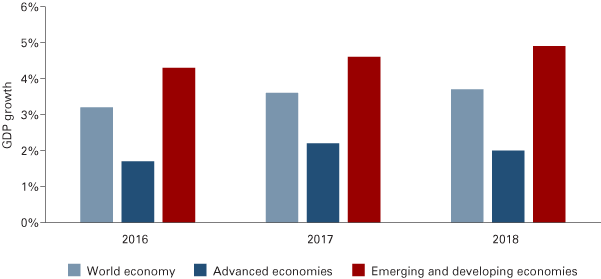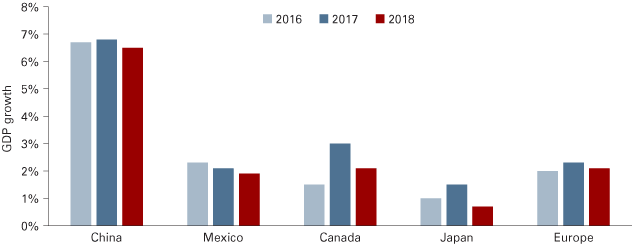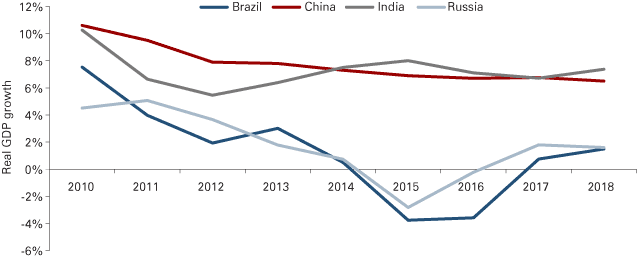International outlook for 2018

Associate Professor of Finance, Kelley School of Business, Indiana University

Clinical Assistant Professor of Business Economics and Public Policy, Kelley School of Business, Indiana University Bloomington
In 2018, the world is definitely expected to be moving on from three successive shocks:
- The financial crisis of 2007-2009
- The eurozone crisis of 2009-2013
- The commodity price crash of 2014-2016
As these extraordinary shocks have faded, confidence has returned, particularly regarding consumer and business optimism. In 2018, for the first time since 2008, virtually no country is expected to experience a recession and the growth rebound of 2017 is forecasted to continue (albeit not as strongly as 2017 for everyone).
Based on International Monetary Fund (IMF) forecasts, global real GDP in 2018 is expected to increase by 3.7 percent. This estimated growth performance is marginally better than the robust 3.6 percent global growth of 2017. The growth is generalized to advanced, emerging and developing economies, and it is better than the historical average for this decade (see Figure 1). The global growth outlook is finally back to the long-term average of the past 30 years, and as a result, the global spare resources (such as unemployment and excess capital) are no longer increasing.
Figure 1: Real GDP growth

Note: 2017 and 2018 values are projections.
Source: International Monetary Fund
Europe
Growth is taking root for the 28 members of the European Union (EU28) and after a growth of 2.3 percent in 2017, the EU28 is expected to grow by 2.1 percent in 2018. Industrial production, household consumption, business investment and exports have rebounded across the EU28, returning to growth rates that would be considered more normal in a period of sustained economic expansion. Those rates should persist in 2018. Unemployment has also receded to its lowest level since November 2008, and this declining trend should persist throughout 2018. The lowest EU unemployment rate was observed in the Czech Republic at 2.9 percent, and the average rate across the union is highest in Greece at 21.2 percent.
The turnaround in the eurozone economy may best be illustrated by the growth performance of countries such as Portugal, Greece and Italy—who after years of painful austerity measures and difficult labor market reforms have seen a boost in their growth, particularly thanks to their exports. This strong performance in the peripheral countries occurred despite a resurgent euro that could have resulted in depressed exports. Furthermore, the recovery in the periphery appears to be more self-sustainable and less in need of public sector support.
Germany, the region’s largest economy, is expected to grow by 1.8 percent in 2018. This continued strong performance is due to the general improvement in the global economy that is stimulating German exports. It can also be traced back to its competitive labor market and investment in the private sector.
On the other hand, the notable exception to this improving European economic outlook, especially over the longer term, is the United Kingdom. This is, of course, the consequence of their vote in summer 2016 to leave the EU (aka Brexit). Since its secession vote, the British economy has been resilient. However, while most European economies are enjoying their best period of growth and stable prices since the financial crisis, the strong depreciation of the pound since June 2017 has resulted in higher consumer prices. This, in turn, has led to higher-than-average inflation rates in the region, which is a significant exception to the pattern of low inflation experienced by its major trading partners.
Mexico
Despite monetary tightening and continued trade-related frictions with the U.S., the Mexican economy is forecasted to continue to show its resilience and grow at 1.9 percent in 2018. The consistent bright spot in the Mexican economy has been its manufacturing exports—particularly its automotive exports. Despite facing continuous threats from the U.S. on their bilateral trade deficit, Mexico’s U.S. exports are expected to continue to show strong growth in 2018.
The higher prices for crude oil globally will continue to boost Mexico’s oil revenue. Also, the trade frictions between the U.S. and Mexico will continue to prompt a spike in Mexican exports, given that Mexican suppliers and U.S. consumers will continue to try to get ahead of any higher future tariffs or quotas. Finally, given Mexico’s relatively low labor costs, in an expanding global economy, it will continue to attract foreign direct investment.
The probability of a recession in Mexico is quite low as within this expansionary period, inflation rates are also expected to be tamed by the central bank’s higher rates that have lifted the value of the peso. On a side note, the September 2017 earthquakes are not expected to have long-term negative effects on the economy, as they did not damage the productive capacity of Mexico (since the infrastructure was largely left unaffected).
Canada
As a commodity exporter, Canada has been experiencing a very strong recovery thanks to the prices of precious metals and oil, which started to increase in 2017 toward their historical norms. However, these commodity prices are still only half of what they were prior to the commodity bubble that proceeded the commodity crisis. Additionally, the Canadian economy has been boosted by government spending on infrastructure, rebounding business investment—particularly in the resource sector—and subsequent rising household wealth.
The ensuing inflationary pressures have resulted in higher monetary policy rates, which in turn have contributed to the appreciation of the Canadian dollar and is expected to keep inflation under its 2 percent target. GDP is forecasted to grow at 2.1 percent, while the unemployment rate is projected to fall to 6.3 percent (the lowest in nine years). The strong growth in Canada is expected to somewhat soften in 2018, but Canada’s growth will remain near its maximum sustainable rate.
Japan
Aggressive economic policy since President Abe’s first election victory in 2012, in addition to strong rising exports to other Asian countries, have created Japan’s tightest labor market conditions since the mid-1970s. However, nominal and real wages have remained sluggish and consumer price inflation has remained well below the 2 percent target. In 2018, Japan should experience slower growth at 0.7 percent (see Figure 2).
Figure 2: Growth in U.S. major trading partners

Note: 2017 and 2018 values are projections.
Source: International Monetary Fund
This dampened growth forecast is driven by fragile domestic demand since rising wages, which are essential in fueling higher consumption, are not materializing even after five years of the most accommodating policies in Japanese history. Furthermore, the recent election that renewed Abe’s mandate is thought of as establishing a too-comfortable status quo—an unsustainable status quo in a country that cannot escape its aging demographics, further shrinking labor force and ensuing loss of productivity.
The BRIC countries
Comprising over half of emerging and developing economy GDP, growth in the BRIC countries (Brazil, Russia, India and China) is expected to boost overall emerging economy growth from 4.3 percent in 2016 to nearly 5 percent by 2018. Continued robust growth from China and India will be aided by a return to positive growth in both Brazil and Russia (see Figure 3).
Figure 3: BRIC real GDP growth

Note: 2017 and 2018 values are projections.
Source: International Monetary Fund
China
China continues to maintain solid growth even as it navigates rebalancing toward a domestic economy less reliant upon investment spending and exports. Recovering global trade and demand for China’s products, a booming housing sector, and increased infrastructure investment spending—such as the “One Belt One Road” corridor—are expected to have boosted GDP by 6.8 percent in 2017, up from 6.7 percent in 2016. While these same forces will support growth in 2018, the pace of growth is forecast to slow to 6.5 percent as the effects of tighter credit conditions begin to be felt.
Inflation remains subdued—though higher—in the wake of rising commodity prices, reaching 2.4 percent by 2018. Rising Chinese consumer demand for both domestic and global products has contributed to a sharp decrease in China’s current account surplus. Reaching its peak of 10 percent of GDP in 2007, this surplus is forecast to drop to 1.2 percent of GDP by 2018.
China’s smooth transition to a robust yet sustainable growth rate is not without risks. A sharp increase in private sector debt burdens, particularly by state-owned enterprises, leaves companies and households vulnerable if financial conditions tighten more than expected. In addition, trade tensions have risen even as China’s current account surplus has fallen, and the imposition of trade restrictions could spark retaliation and could negatively impact investor confidence, global trade and China’s economic growth. As the world’s second-largest economy, a sharper decrease in growth would have repercussions on the global economy.
India
India’s economy continues to benefit from lower commodity prices, economic reform measures and increased foreign direct investment. After growing by 7.1 percent in 2016, growth was expected to fall slightly to 6.7 percent in 2017 as the economy adjusted to two policy shocks:
- The November 2016 announcement of the demonetization of Indian rupee 500 and 1000 notes
- The July 2017 initiation of a national goods and services tax
Both actions will likely benefit India’s economy over the longer term as the retiring of large notes will reduce black market and counterfeit activity and as tax reform creates a more efficient system of taxation. Additional government reform measures undertaken in licensing, investor protection and bankruptcy laws have improved the business environment in India, as reflected in India’s 30-point increase in the World Bank’s recent 2018 Ease of Doing Business ranking. As a result, India’s economy is expected to increase by a stronger 7.4 percent rate in 2018, with inflation stable at just under 5 percent.
Brazil and Russia
Brazil and Russia, both commodity exporters, have emerged from recessions and experienced positive economic growth rates in 2017. The recovery of commodity prices, a successful agricultural harvest and rising consumer spending have combined to lift Brazil’s growth to 0.7 percent in 2017—a significant improvement over last year’s 3.6 percent decline in output. Inflation is expected to remain below the central bank’s 4.5 percent inflation target in both 2017 and 2018, providing a boost to consumer purchasing power.
However, high unemployment, weak investment, and political and policy uncertainty are expected to restrain growth to a modest 1.5 percent in 2018. A restoration of confidence along with reforms to lower Brazil’s budget deficit will be needed if the economy is to return to its pre-recession growth rates.
Russia is expected to grow by 1.8 percent in 2017, aided by the stabilization of oil prices, easier credit conditions, and improved consumer spending and business investment spending. Inflation remains moderate at around 4 percent, and the ruble’s value has strengthened from its low point in 2016. Further improvements in growth appear unlikely, however, as stable oil prices, a stronger ruble, sanctions on non-oil exports and an aging labor force are expected to lower growth to 1.6 percent in 2018.
Conclusion
While higher consumer spending, trade and business capital investment combine to provide “a fountain of youth for an aging recovery,” several risks weigh on this positive global forecast. Some risks are geopolitical, coming from concerns of escalating tensions with countries, such as North Korea, the Republic of Iran and Russia.
However, some risks remain purely economic and center on the adjustments that many countries will have to make to the anticipated departure from a decade of very loose monetary policy and cheap access to credit. In some countries, this access to cheap credit has led to a buildup of debt that risks being unsustainable if growth is less than projected. Additionally, uncertainties about the reappearance of strong protectionism will add significant downside risks to the global forecast.
References
- International Monetary Fund, “World Economic Outlook: Seeking Sustainable Growth,” October 2017, www.imf.org/en/Publications/WEO/Issues/2017/09/19/world-economic-outlook-october-2017.
- International Monetary Fund, “Global Financial Stability Report: Is Growth at Risk?” October 2017, www.imf.org/en/Publications/GFSR/Issues/2017/09/27/global-financial-stability-report-october-2017.
- World Bank, “Doing Business 2018,” October 2017, www.doingbusiness.org/reports/global-reports/doing-business-2018.



